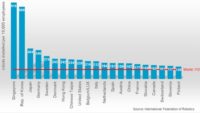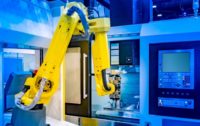According to the International Federation of Robotics (IFR), five big automation trends are affecting manufacturers around the globe.
“Advances in robot technologies are contributing to increase adoption,” says Susanne Bieller, general secretary of the IFR. “The mission to combine traditional production with ‘go-digital strategies’ puts robots in a pole position.
“The COVID-19 pandemic hasn’t started any new trends, but it has accelerated the use of robotics beyond established practice,” claims Bieller. “In this respect, the pandemic has proven to be the biggest single driver for change in industry.”
According to Bieller, the following trends are driving demand for robotics technology:
*Robots learn new tricks. Artificial intelligence software in combination with vision and other sensing systems, allow robots to master difficult tasks, such as bin picking.
“New generations of robots are easier to install and program, and they are connectable,” notes Bieller. “Advances in communication protocols integrate robots seamlessly into automation and Industry 4.0 strategies.”
*Robots work in smart factories. The automotive industry pioneered smart factory systems equipped with industrial robots. According to IFR, future factories will increasingly employ autonomous mobile robots (AMRs), which combine robots and autonomous guided vehicles.
“Equipped with the latest navigation technology, these mobile robots are much more flexible compared to traditional production lines,” says Bieller. “Car bodies are conveyed on driverless transport systems. They can be decoupled from the assembly line flow and redirected to assembly stations where individually equipped variants can be assembled.
“When models are changed completely, it is only necessary to reprogram the robots and AMRs rather than to dismantle the entire production line,” explains Bieller. “With the integration of human-robot collaboration workstations picking up momentum, [more] robots will work hand-in-hand with humans without fencing.”
*Robots enter new markets. Due to connectivity breakthroughs, there will be increased robot adoption in manufacturing sectors that have only recently turned to automation, such as food and beverage, plastics, textiles and wood products.
“Ongoing digital transformation will lead to completely new business models, because producers can diversify more easily than ever,” says Bieller. “In the smart factory, different products are assembled subsequently by the same equipment; the traditional production line no longer exists.”
*Robots reduce carbon footprint. Investments in state-of-the-art robotic technology will also be driven by the requirement for a smaller carbon footprint. Because modern robots are energy-efficient, they reduce energy consumption.
“Through higher precision, they also produce fewer defects and substandard goods, which has a positive impact on the ratio of resource input over output,” claims Bieller. “In addition, robots help in the cost-efficient production of renewable energy equipment, such as photovoltaics and hydrogen fuel cells.”
*Robots help to secure supply chains. The COVID-19 pandemic has made the weakness of global supply chains visible. Manufacturers have the opportunity to rethink supply with a completely different outlook.
“When productivity is leveled through automation, manufacturers have increased flexibility that may not have been available in high-wage countries like most of the European Union, North America, Japan or the Republic of Korea,” says Bieller. “Robotic automation offers productivity, flexibility and security.”







